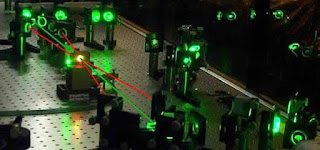CO2 Laser
How sealed tube Carbon Dioxide Laser works
[In brief]
A sealed tube
carbon dioxide [CO2] laser works by exciting a mixture of gases, typically
carbon dioxide (CO2), nitrogen (N2), and helium (He), inside a sealed glass
tube. The tube contains a pair of mirrors, one of which is partially
reflective, at either end.
When an electric discharge is applied to the gas mixture inside the tube, it excites the molecules, causing them to emit photons. These photons bounce back and forth between the mirrors, creating a standing wave of light that becomes amplified as it passes through the excited gas. As the light wave passes back and forth through the excited gas molecules, it causes additional emissions, creating more photons in phase with the original wave. This process of stimulated emission amplifies the light wave, creating a coherent and intense beam of laser light that is emitted through the partially reflective mirror. The wavelength of the laser beam is determined by the specific gases used in the mixture, with CO2 lasers typically emitting light at a wavelength of 10.6 micrometers in the far-infrared region of the electromagnetic spectrum. CO2 sealed tube lasers are typically designed to operate continuously without the need for gas replenishment due to the sealed nature of the glass tube. The laser beam can be focused and directed using mirrors and lenses, making them useful in various industrial, medical, and scientific applications.




Comments
Post a Comment